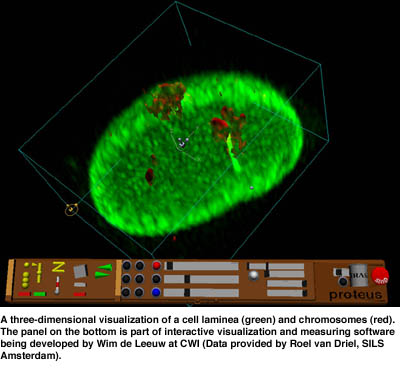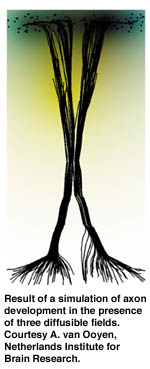


by Jan Verwer and Annette Kik
The 20th century has been a period of dramatic technological and scientific breakthroughs and discoveries. A general feeling amongst scientists in all areas is that developments in science and technology will go on, perhaps most notably in the life and computer sciences as testified by the current rapid progress in bio- and information technology. New subdisciplines have been created such as computational biology and bioinformatics, which are at the crossroads of biology, physics, chemistry, informatics and mathematics. CWI is active in a number of projects with life science applications while other projects are forthcoming.
One of our current projects is ‘Macro-Molecular Crowding in Cell Biology’, in co-operation with several cell biologists. Living cells are relatively densely packed with macromolecules (proteins), implying that diffusion of larger molecules can be much slower than diffusion of smaller ones. This crowding effect is important for the uptake of molecules entering a cell (glucose). The influence of this crowding effect is as yet largely unknown. The aim is to study metabolic control in pathways by means of numerical and analytical studies of systems of reaction-diffusion equations which take into account effects of molecular crowding.
Another project is ‘Analysis of Biological Structures by Virtual Reality Techniques’. This aims at exploring the potentials of virtual reality visualization techniques in order to obtain detailed insight into complex biological structures. Such structures include proteins and cellular structures, as wel as organs and complete organisms. Visualization of biological structures is a key step in understanding normal and pathological biological processes and systems, such as biocatalysis, signal transduction, gene expression and embryonal development.
Our forthcoming projects have different applications. CWI will study models for the development of phytoplankton blooms. Phytoplankton lies at the beginning of the food chain in oceans and takes up large amounts of carbon dioxide from the atmosphere. Hence there is a clear link with climate research. The complicated models require efficient numerical solution techniques.
The project ‘Distributed Visualization of Biological Structures’ aims at the development of an experimental platform to study advanced image processing techniques for cell structures and interaction schemes for remote steering of a laboratory apparatus, in the context of high speed networks. Interactive distributed visualization coupled with virtual environments allows for collaborative analysis, interrogation of large repositories of biological structures and distance learning.
Since about a decade, scientists realise that many biological and physical systems seem to drive themselves, without precise external tuning, towards a state which resembles a typical equilibrium statistical mechanics system at the critical point. Examples are certain types of epidemics, forest fires, and processes in the brain. Most studies of this this so-called Self-Organized Critical behaviour are of a very heuristic nature, whereas we will use a more rigorous mathematical approach.

A hot question in neuroscience is how the hand-shaped ends of axons growing out of neurons explore the territory they traverse on their way to a target tissue. This growth process is partly guided by concentration gradients of biochemical molecules in the extracellular space, arising from diffusion and various chemical interactions. This leads to models consisting of parabolic equations coupled with gradient-type equations for the positions of the axons. We will study these models and their numerical solution and implement efficient numerical algorithms in software that is user-friendly for neuroscientists, as a joint activity with the Netherlands Institute for Brain Research.
Furthermore, there is a whole range of problems linking to Combinatorial Optimization. For instance, the primary access to the functionality of molecules is through laboratory experiments. However, experimental data typically provide only partial information about structures and properties under investigation. This prompts the problem of recovering the actual molecular, chemical properties and structures from the incomplete data. This often leads to so-called combinatorial optimization problems. In biology the complexity is very large, so that there will be a need to improve or redesign existing optimization methods or even come up with totally new ideas.
Finally, CWI plans to do research in the field of Control and System Theory for the Life Sciences. The aim of this research is to gain understanding of the feedback control in cells, plants, living beings, and in ecological communities. This understanding may be used to develop treatments for diseases, and for ecological communities.
Links:
http://www.cwi.nl/~janv
Please contact:
Jan Verwer - CWI
Tel: +31 20 592 4095
E-mail: Jan.Verwer@cwi.nl
Mark Peletier - CWI
Tel: +31 20 592 4226
E-mail Mark.Peletier@cwi.nl